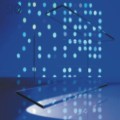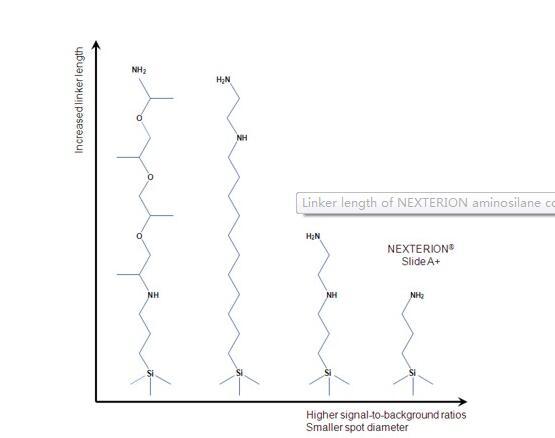
生物芯片 基因芯片NEXTERION® Slide A+
产品名称: 生物芯片 基因芯片NEXTERION® Slide A+
英文名称: NEXTERION® Aminosilane(Slide A+)
产品编号: 基因芯片002
产品价格: 0
产品产地: 德国
品牌商标: SCHOTT NEXTERION®
更新时间: null
使用范围: null
- 联系人 :
- 地址 : 萝岗开发区科学城南云一路2号历康实业大楼3层
- 邮编 : 510663
- 所在区域 : 广东
- 电话 : 185****9007
- 传真 : 020-82510371
- 邮箱 : don.zeng@siooptics.com
可用于高通量测序、第二、三代基因测序、单分子测序、环氧基修饰基因芯片、醛基修饰基因芯片、氨基修饰基因芯片、探针类型寡核苷酸、探针类型cDNA/PCR、探针类型人工染色体(BAC)、组织芯片、DNA芯片、细胞芯片、细胞分析、细胞培养、新一代测序技术、基因诊断、癌症诊断、全基因组重测序、全转录组测序、DNA甲基化测序(MeDIP-Seq)、染色质免疫沉淀测序(ChIP-Seq)、目标序列捕获测序、人全外显子组测序、基因序列、杂交技术、克隆技术、血糖技术等研究调查。
Aminosilane coating
NEXTERION® Slide A+
Aminosilane coated slides remain the most popular choice for printing PCR products, and long oligonucleotides, despite the emergence of innovative three-dimensional microarray surfaces, and other “active” surface chemistries such as epoxysilane. With it's NEXTERION®Slide A+ SCHOTT is committed to providing the best aminosilane microarray slides on the market.
Overview
Type of coating | Immobilization method | Typical probes | Ordering information | |||
NEXTERION®product | Barcode option | Item number | Slides per pack | |||
Aminosilane | Ionic interaction followed by cross-linking via an additional UV or baking step | • Long oligonucleotides | Slide A+ | None | 1064875 | 25 |
Laser | 1064877 | 25 | ||||
Key product features | |||||||||||||||||||||||||||||||||||
• Printed slides have a long shelf life | |||||||||||||||||||||||||||||||||||
• Compatible with a wide range of spotting buffers | |||||||||||||||||||||||||||||||||||
• Coatings with uniform aminosilane density | |||||||||||||||||||||||||||||||||||
• Regular spot uniformity and morphology |
Typical applications | |||||||||||||||||||||||||||||||||||
• ArrayCGH | |||||||||||||||||||||||||||||||||||
• Transcriptional profiling | |||||||||||||||||||||||||||||||||||
• SNP genotyping | |||||||||||||||||||||||||||||||||||
• Splice variant detection | |||||||||||||||||||||||||||||||||||
• DNA methylation profiling |
Suitable probe types | |||||||||||||||||||||||||||||||||||
• BACS or PACs | |||||||||||||||||||||||||||||||||||
• Oligonucleotides ≥ 40 mers | |||||||||||||||||||||||||||||||||||
• Small protein fragments such as peptides | |||||||||||||||||||||||||||||||||||
• cDNA |
Introduction
Aminosilane surfaces provide available amine groups for initial ionic attachment of the negatively charged phosphate groups in the DNA backbone. Conventional wisdom is that longer aminosilane molecules with multiple amino groups produce higher signal-to-background ratios, as their higher positive charge will bind more DNA to the slide surface. However, recent research at SCHOTT has shown that the situation is actually more complicated than this, and that while surfaces with a higher charge do bind more DNA, they are also more difficult to block effectively, resulting in significantly higher non-specific binding. The higher levels of non-specific binding have a negative effect leading to poorer signal-to-background ratios.

Comparison of aminosilane structures
The aminosilane slide offered by SCHOTT is based on very short chain aminosilanes that demonstrate high signal intensities, and exceptionally low background signals, when compared with other commercially available aminosilane slides.

Immobilization chemistry
Aminosilane coated slides have a high concentration of primary aminogroups available at the surface. These groups become protonated and therefore positively charged when placed in contact with a near-neutral, aqueous solution. Negatively charged probe molecules, such as DNA, will initially form multiple ionic interactions with the positively charged amino surface coating. Additional amino-modifications of the nucleic acids are not required, but such modifications do not interfere with the immobilization. After spotting, the probes are covalently linked to the slide surface by either heating, or a brief exposure to ultraviolet (UV) light. Other types of negatively charged biomolecules may also be coupled to aminosilane surfaces.

SCHOTT slides are manufactured from a high quality, low intrinsic fluorescence borosilicate glass. The glass slides are cleaned and coated in a class 100, environmentally controlled clean room to ensure contamination and artifact free surfaces. The aminosilane coatings are applied using a unique, and innovative method developed and optimized by SCHOTT, that allows the production of large lot sizes with excellent intra-lot, and inter-lot reproducibility. Each slide lot is tested using both physical and functional quality control checks. The density of the aminosilane groups in the coatings remain uniform over the entire surface of the slides, and is optimized to maximise the DNA binding capacity. The surface hydrophobicity is tightly controlled to optimize the performance with both contact and non-contact microarray printers. The Slide A+ surface is more hydrophobic than the AStar surface, resulting in smaller spots, making it ideally suited for printing higher density arrays.
NEXTERION® Slide A+, and Slide AStar are compatible with the most commonly used aminosilane protocols and a wide range of spotting buffers. This makes it easy to evaluate and switch to the NEXTERION® aminosilane slides from competitor slides.
Selecting the most suitable NEXTERION® aminosilane coating
Choosing the best SCHOTT aminosilane slide for the application depends on a number of factors. One important factor is the buffer used for printing the arrays. SCHOTT has developed a printing buffer system (NEXTERION® Spot A HD) for printing high-density arrays of up to 50k spots on the SCHOTT aminosilane slides. The buffer system is designed to minimize sample evaporation during long print runs.

Format
NEXTERION® Slide AStar and A+ are available in packs of 25-slides with optional code 128 barcodes enabling automated sample tracking. The AStar and A+ aminosilane coating are also available in 16-well slide, 48-well slide and 96-well microplate formats. For further information refer to the section on “Multi-well formats”.


